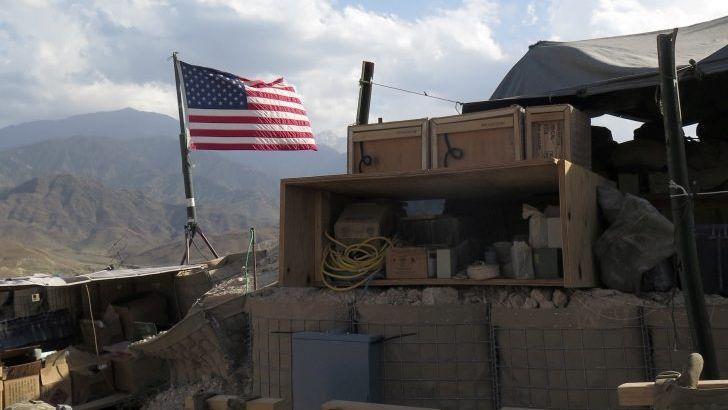After Syria, Trump planning ‘troop withdrawal from Afghanistan’
A day after Syria move, US officials reportedly say Trump also decided to pull thousands of troops out of Afghanistan.

US President Donald Trump is planning to pull thousands of US troops out of Afghanistan, reports have said, a day after the Republican president rebuffed top advisers and announced the withdrawal of all US soldiers from Syria.
The reported move comes as US officials are currently engaged in talks with the Taliban, which was toppled following a Washington-led invasion in 2001 but now controls a significant amount of Afghan territory.
Keep reading
list of 4 itemsPhotos: Tourist numbers up in post-war Afghanistan
Taliban ban on girls’ education defies both worldly and religious logic
Afghanistan calls for ‘respect’ after Cricket Australia snub
Trump’s surprise decision to withdraw soldiers from Syria contributed to the abrupt resignation of Pentagon chief Jim Mattis on Thursday over significant policy differences with the president.
Mattis had also argued for maintaining a strong US military presence in Afghanistan to bolster diplomatic peace efforts. He quit shortly after US officials raised the possibility that Trump would order the withdrawal.
The United States has about 14,000 troops in Afghanistan working either with a NATO mission to support Afghan forces or in separate counterterrorism operations.
US officials, speaking on the condition of anonymity, were quoted by news agencies and media in the US saying that the Pentagon was developing plans for the reduction of US forces in Afghanistan.
The Wall Street Journal reported that more than 7,000 troops would be returning in the coming weeks. Other reports put the figure to over 5,000, while AFP news agency quoted a US official as saying that a “significant withdrawal” will take place.
The reports could not be independently verified.
Speaking on the condition of anonymity, one US official told The Associated Press news agency that the troops could be out of Afghanistan by summer, but no final decision has been made.
It is unclear how the US, with significantly fewer troops in Afghanistan, will be able to fulfill the full set of missions now under way, including training Afghan forces, advising them in the field, and waging an air campaign against the Taliban and other armed groups.
Instead, Washington almost certainly would have to curtail its missions, something that could provide an opportunity for a resurgent Taliban to expand their offensives across Afghanistan.
The Pentagon declined to comment on Afghanistan.
Garrett Marquis, a spokesperson for the National Security Council, said the White House would not comment “on future strategic developments”.
Civilian casualties
US troops stormed into Afghanistan in November 2001 in an invasion that followed the September 11, 2001 attacks on the World Trade Center and the Pentagon.
Last month, a study by the Brown University’s Watson Institute for International and Public Affairs found that hundreds of thousands of people have been killed due to the so-called “war on terror” launched by the US in the wake of the 9/11 attacks, including 38,480 civilians in Afghanistan.
An estimated 2,798 civilians have been killed and 5,252 others wounded in attacks across the country from January to September this year, according to the United Nations Assistance Mission in Afghanistan (UNAMA).
Afghanistan’s President Ashraf Ghani meanwhile said in November that 28,529 Afghan security forces had been killed since the start of 2015, a figure far higher than anything previously acknowledged. That is an average of about 20 soldiers killed every day.
The surge in violence comes as the US is pushing for a peaceful resolution to the 17-year-old conflict, while the Taliban has increasingly asserted control over vast tracts of the country.
Trump privately has been complaining about US military involvement in Afghanistan, telling an ally as recently as Wednesday words to the effect of, “What are we doing there? We’ve been there all these years.”
Republican Senator Lindsey Graham, often a vocal Trump ally, warned of possible danger to the US if the withdrawal goes through.
“The conditions in Afghanistan – at the present moment – make American troop withdrawals a high-risk strategy. If we continue on our present course we are setting in motion the loss of all our gains and paving the way towards a second 9/11,” Graham said in a statement.
Trump last year approved an increase in US troops but acknowledged that he did so reluctantly.
Earlier this week, US Special Envoy Zalmay Khalilzad and Taliban representatives held talks in Abu Dhabi on a deal that would end the war. Officials from Saudi Arabia and the United Arab Emirates also took part.
The Saudi ambassador to Washington, Khalid bin Salman, tweeted on Thursday that the discussions had been productive and would bring “very positive results by the beginning of next year”.
But a former senior State Department official familiar with the issue said that the Taliban representatives rejected a proposal by Khalilzad for a ceasefire and demanded that the talks focus on a US withdrawal.